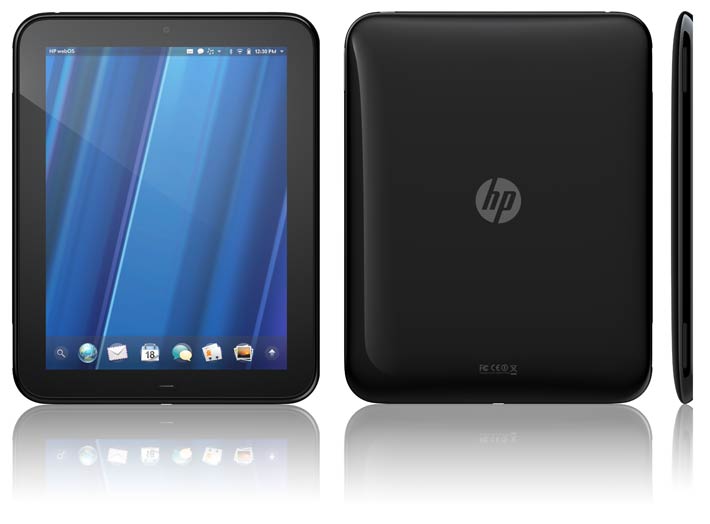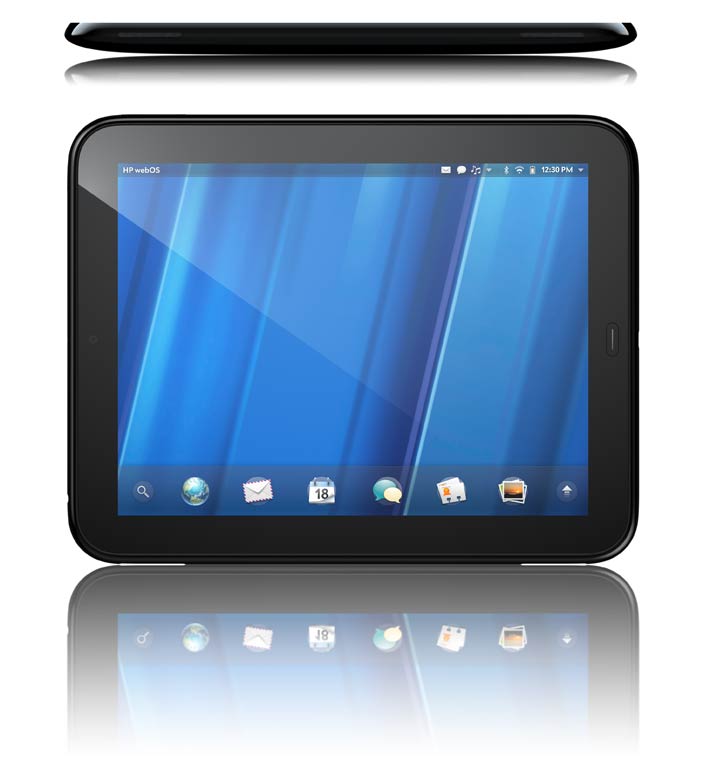The HP TouchPad
Sharing the iPad's size and design,
HP hopes webOS will make the difference
by Conrad H. Blickenstorfer
On February 7, 2011, HP finally announced their long-awaited tablet. That's a year and ten days since Apple announced the iPad, and what an incredible difference that year has made. Initially dissed by many, the iPad sold well over ten million last year alone, changing computing as we know it in the process. Microsoft had no answer, not yet anyway, and Google's Android really isn't a tablet OS (yet), and so no one mounted a challenge. Now HP has, and it's not in the form of the Windows-based tablet Steve Ballmer showed at CES 2010, or even the somewhat awkwardly named HP Slate 500 Tablet PC HP itself half-heartedly brought on the market late 2010. Instead, the HP TouchPad uses Palm's WebOS, which, since HP bought what was left of Palm in early 2010, is now called HP WebOS. So here is the HP TouchPad. It measures 7.48 inches x 9.53 inches x .54 inches, weighs 1.6 pounds, and has a 9.7-inch capacitive multi-touch screen with 1024 x 768 pixel resolution. That compares to the iPad's 7.47 x 9.56 x 0.5 inches, 1.5 pounds, and 9.7-inch capacitive multi-touch screen with 1024 x 768 pixel resolution. Yes, it's an exact copy. Why did HP do that?

Because HP is damned if they copy the iPad, and damned if they don't. Apparently Apple hit it so much on the nose with the iPad that it simply doesn't seem to make sense to do it any different. Sure, pundits initially mocked Apple for using the "old-fashioned" 4:3 aspect ratio instead of the snazzy new wide format. Ten million and counting iPads later, apparently people have no problem with the screen (other than its annoyingly glossy surface). So HP copies that, too.
There is, of course, something different, and that's the webOS. First introduced by Palm for use on its Pre and then Pixi smartphones, the webOS got very good reviews. Palm certainly knows how handhelds should work and operate, and the webOS, by all accounts, is just the polished, intelligent platform one exected from Palm. Unfortunately it never got any traction in a smartphone market dominated by RIM and Apple, and what little room there was a year ago for a challenger was quickly usurped by Android. Now that Palm is part of HP, the question is whether webOS smartphones can get enough market attention to remain worthwhile (HP does not have a good track record there; they let the once leading Compaq iPAQ brand fall into neglect). And the other question is whether webOS scales well into tablet size.
But let's take a look at what HP cooked up with the TouchPad.
In terms of tech specs, the TouchPad is powered by a 1.2GHz Qualcomm "Snapdragon" APQ860 dual processor. There is either 16 or 32GB of storage (why not 64 when Apple offers it?), 802.11b/g/n WiFi, 3G WWAN with A-GPS, Bluetooth 2.1 + EDR, light sensor, accelerometer, compass and gyroscope. For connectivity there's a Micro-USB port for charging and PC syncing, a 3.5mm audio jack. There's also a front-facing 1.3-megapixel camera, something which is not part of the first gen iPad. Battery capacity is given as 6,300mAH, but the specs say nothing about voltage or expected battery life (which, of course, is a big issue given the iPad's excellent battery life).

That's all good, but not great. As of now, all the HP TouchPad (which shares its name with the shortlived Gateway Touchpad of a decade ago) really says is that an exact copy of the original iPad is the best way to go, and let's see if perhaps the webOS gains traction. Worse, you can't get a TouchPad, you don't know what networks it will support, what it will cost, and when it will be available. All HP says is "HP TouchPad is scheduled to be available in the summer. Exact pricing and availability will be announced at a later date."
Summer is a long ways away. Much can happen between now (early February) and then, and without knowing the price, it's hard to predict where the TouchPad will fit in. Then there's the fact that the webOS failed to catch on the first time around, and so HP and Palm will have to find an angle there. Given the anticipated size of the tablet market, and given the fact that HP makes good hardware and Palm good software, it's quite possible that even modest success may be a good business proposition for HP. But if Microsoft continues dragging and HP makes the TouchPad a loss leader, the sky just may be the limit.
For now, check out the TouchPad here at the Palm site, and HP's TouchPad press release is here.
|





























